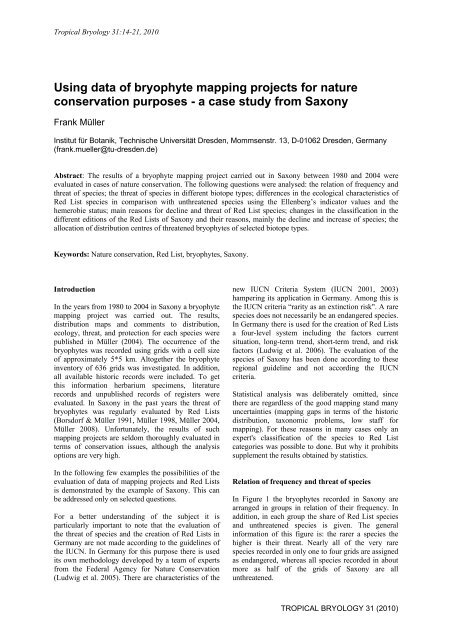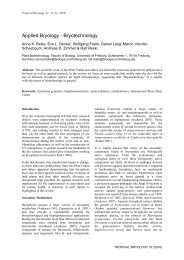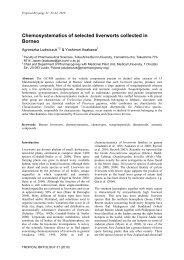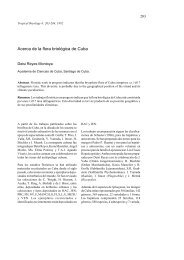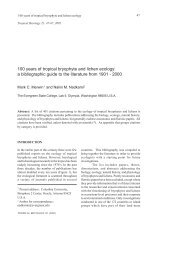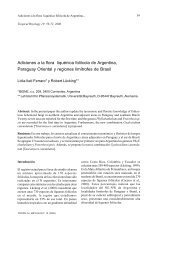Full text pdf - Tropical Bryology
Full text pdf - Tropical Bryology
Full text pdf - Tropical Bryology
You also want an ePaper? Increase the reach of your titles
YUMPU automatically turns print PDFs into web optimized ePapers that Google loves.
<strong>Tropical</strong> <strong>Bryology</strong> 31:14-21, 2010<br />
Using data of bryophyte mapping projects for nature<br />
conservation purposes - a case study from Saxony<br />
Frank Müller<br />
Institut für Botanik, Technische Universität Dresden, Mommsenstr. 13, D-01062 Dresden, Germany<br />
(frank.mueller@tu-dresden.de)<br />
Abstract: The results of a bryophyte mapping project carried out in Saxony between 1980 and 2004 were<br />
evaluated in cases of nature conservation. The following questions were analysed: the relation of frequency and<br />
threat of species; the threat of species in different biotope types; differences in the ecological characteristics of<br />
Red List species in comparison with unthreatened species using the Ellenberg’s indicator values and the<br />
hemerobie status; main reasons for decline and threat of Red List species; changes in the classification in the<br />
different editions of the Red Lists of Saxony and their reasons, mainly the decline and increase of species; the<br />
allocation of distribution centres of threatened bryophytes of selected biotope types.<br />
Keywords: Nature conservation, Red List, bryophytes, Saxony.<br />
Introduction<br />
In the years from 1980 to 2004 in Saxony a bryophyte<br />
mapping project was carried out. The results,<br />
distribution maps and comments to distribution,<br />
ecology, threat, and protection for each species were<br />
published in Müller (2004). The occurrence of the<br />
bryophytes was recorded using grids with a cell size<br />
of approximately 5*5 km. Altogether the bryophyte<br />
inventory of 636 grids was investigated. In addition,<br />
all available historic records were included. To get<br />
this information herbarium specimens, literature<br />
records and unpublished records of registers were<br />
evaluated. In Saxony in the past years the threat of<br />
bryophytes was regularly evaluated by Red Lists<br />
(Borsdorf & Müller 1991, Müller 1998, Müller 2004,<br />
Müller 2008). Unfortunately, the results of such<br />
mapping projects are seldom thoroughly evaluated in<br />
terms of conservation issues, although the analysis<br />
options are very high.<br />
In the following few examples the possibilities of the<br />
evaluation of data of mapping projects and Red Lists<br />
is demonstrated by the example of Saxony. This can<br />
be addressed only on selected questions.<br />
For a better understanding of the subject it is<br />
particularly important to note that the evaluation of<br />
the threat of species and the creation of Red Lists in<br />
Germany are not made according to the guidelines of<br />
the IUCN. In Germany for this purpose there is used<br />
its own methodology developed by a team of experts<br />
from the Federal Agency for Nature Conservation<br />
(Ludwig et al. 2005). There are characteristics of the<br />
new IUCN Criteria System (IUCN 2001, 2003)<br />
hampering its application in Germany. Among this is<br />
the IUCN criteria “rarity as an extinction risk". A rare<br />
species does not necessarily be an endangered species.<br />
In Germany there is used for the creation of Red Lists<br />
a four-level system including the factors current<br />
situation, long-term trend, short-term trend, and risk<br />
factors (Ludwig et al. 2006). The evaluation of the<br />
species of Saxony has been done according to these<br />
regional guideline and not according the IUCN<br />
criteria.<br />
Statistical analysis was deliberately omitted, since<br />
there are regardless of the good mapping stand many<br />
uncertainties (mapping gaps in terms of the historic<br />
distribution, taxonomic problems, low staff for<br />
mapping). For these reasons in many cases only an<br />
expert's classification of the species to Red List<br />
categories was possible to done. But why it prohibits<br />
supplement the results obtained by statistics.<br />
Relation of frequency and threat of species<br />
In Figure 1 the bryophytes recorded in Saxony are<br />
arranged in groups in relation of their frequency. In<br />
addition, in each group the share of Red List species<br />
and unthreatened species is given. The general<br />
information of this figure is: the rarer a species the<br />
higher is their threat. Nearly all of the very rare<br />
species recorded in only one to four grids are assigned<br />
as endangered, whereas all species recorded in about<br />
more as half of the grids of Saxony are all<br />
unthreatened.<br />
TROPICAL BRYOLOGY 31 (2010)
species number<br />
350<br />
300<br />
250<br />
200<br />
150<br />
100<br />
50<br />
0<br />
MÜLLER: BRYOPHYTE MAPPING PROJECTS FOR NATURE CONSERVATION PURPOSES<br />
1‐4 5‐20 21‐40 41‐300 301‐500 501‐636<br />
frequency<br />
0 1 2 3 R unthreatened<br />
Figure 1. Correlation between frequency of the<br />
bryophytes of Saxony and threat. The frequency is<br />
ordered in groups according the number of grids with<br />
records. Abbreviations: 0 – extinct, 1 – critically<br />
endangered, 2 – endangered, 3 – vulnerable, R – rare.<br />
The most frequent species in Saxony are Dicranum<br />
scoparium, Brachythecium salebrosum, Aulacomnium<br />
androgynum, Eurhynchium praelongum,<br />
Rhytidiadelphus squarrosus, Brachythecium albicans,<br />
Plagiomnium affine, Mnium hornum, Lophocolea<br />
heterophylla, Polytrichum formosum, Tortula muralis,<br />
Amblystegium serpens var. serpens, Bryum<br />
argenteum, Brachythecium velutinum, Atrichum<br />
undulatum, Dicranella heteromalla, Hypnum<br />
cupressiforme var. cupressiforme, Pohlia nutans,<br />
Brachythecium rutabulum, and Ceratodon purpureus.<br />
The last one is the commonest one recorded in nearly<br />
all of the investigated grids.<br />
The threat of species in different biotope types<br />
The information of the ecology of each species were<br />
evaluated and to each species the mean biotope types<br />
of their occurrences were assigned (Fig. 2). Due to<br />
multiple selections the total sum exceeds the number<br />
of the 712 species recorded in Saxony. Most species,<br />
nearly 70%, are able to inhabit rock and immature soil<br />
biotopes. In Saxony these formations play the most<br />
important role for bryophyte biodiversity. A<br />
comparative high proportion of bryophytes are<br />
characteristic for forest biotopes. All the other biotope<br />
types are characterized by relative low species<br />
diversity. The species inventory of the biotope types<br />
“bogs and fens”, “bodies of standing water”, and<br />
“bodies of flowing waters” is limited, but contain a<br />
high proportion of specialized species, whereas the<br />
inventory of the biotope types “settlements,<br />
infrastructure and industrial areas’, “arable land,<br />
gardens, areas with specialised cultivations”,<br />
“heathlands and neglected grassland”, “populations of<br />
perennial herbs”, “grassland”, “shrubberies,<br />
hedgerows and bosks” are also limited, but contains<br />
mostly species with a wide ecological range.<br />
It should be noted here that a part of the bryophytes<br />
recorded in Saxony show a very limited ecological<br />
TROPICAL BRYOLOGY 31 (2010)<br />
range and some are only known from man-made<br />
substrates. Only on open soil on paths were recorded<br />
the species Bryum oblongum, Bryum knowltonii (the<br />
recent record), Campylopus subulatus, Jungermannia<br />
paroica, and Meesia uliginosa (the recent record).<br />
Only from walls there are known Didymodon<br />
cordatus (the recent records), Didymodon luridus,<br />
Didymodon umbrosus, Ditrichum flexicaule (the<br />
recent record), Grimmia crinita, Isopterygiopsis<br />
pulchella, Jungermannia confertissima, Scapania<br />
cuspiduligera, and Tortella densa. Restricted in their<br />
occurrence to mining areas, e. g. quarries, opencast<br />
pits, there are Aloina aloides, Bryum funckii (the<br />
recent records), Bryum radiculosum, Cephaloziella<br />
massalongi, Cephaloziella phyllacantha, Dicranella<br />
crispa, Lophozia guttulata, Nardia insecta,<br />
Palustriella commutata var. falcata (the recent<br />
record), Pohlia tundrae, and Riccia ciliata (the recent<br />
record).<br />
Figure 3 shows the share of unthreatened and Red List<br />
species for each mean biotope type. The share of Red<br />
List species is remarkably high in bog and fen<br />
biotopes. More then two-thirds of the species<br />
occurring in this biotope type are listed in the Red<br />
List. In the biotope types “forests”, “rock and<br />
immature soil biotopes”, “bodies of standing water”,<br />
“bodies of flowing waters”, “heathlands and neglected<br />
grassland” the share of Red List species and<br />
unthreatened species is nearly identical. The share of<br />
Red List species is significantly low in the biotope<br />
types “settlements, infrastructure and industrial<br />
areas”, “arable land, gardens, areas with specialised<br />
cultivations”, “populations of perennial herbs”,<br />
“grassland”, and “shrubberies, hedgerows and<br />
bosques”.<br />
Differences in the ecological characteristics of Red<br />
List species in comparison with unthreatened<br />
species<br />
As one example to estimate the different ecological<br />
amplitude of Red List species in comparison with<br />
unthreatened species the Ellenberg’s indicator values<br />
of both groups were compared (Ellenberg et al. 2002).<br />
The Ellenberg's indicator values are simple ordinal<br />
classes of plants with a similar realized ecological<br />
niche along a gradient. The latest edition of<br />
Ellenberg's indicator values contains values on a 9<br />
point scale for soil acidity, soil humidity,<br />
continentality, temperature, and light.<br />
The evaluation of the diagrams (Figs. 4–8) shows that<br />
in all five examined indicator values differences in in<br />
the spectrums between Red List species and<br />
unthreatened species exist. Under extreme habitat<br />
conditions the proportion of Red List species in<br />
comparison with unthreatened species is usually<br />
higher. Under average habitat conditions, the<br />
15
16<br />
arable land, gardens, areas with specialised cultivati ons<br />
biotope type<br />
settlements, infrastructure and industrial areas<br />
MÜLLER: BRYOPHYTE MAPPING PROJECTS FOR NATURE CONSERVATION PURPOSES<br />
rock and immature soil biotopes<br />
heathland and neglected grassland<br />
populations of perennial herbs<br />
grassland<br />
bogs and fens<br />
bodies of standing water<br />
bodies of flowing water<br />
shrubberies, hedgerows and bosks<br />
forests<br />
42<br />
76<br />
79<br />
100<br />
98<br />
112<br />
126<br />
127<br />
159<br />
325<br />
species number<br />
Figure 2. Species number of bryophytes in the eleven<br />
main biotope types of Saxony.<br />
species number in %<br />
45<br />
40<br />
35<br />
30<br />
25<br />
20<br />
15<br />
10<br />
5<br />
0<br />
T1 T2 T3 T4 T5 T6 T7 T8 T9<br />
indicator value for temperature<br />
unthreatened species red list species<br />
Figure 4. Indicator values for temperature of Red List<br />
bryophytes in comparison with unthreatened<br />
bryophytes in Saxony.<br />
species number in %<br />
25<br />
20<br />
15<br />
10<br />
5<br />
0<br />
R1 R2 R3 R4 R5 R6 R7 R8 R9<br />
indicator value for soil acidity<br />
unthreatened species red list species<br />
Figure 6. Indicator values for soil acidity of Red List<br />
bryophytes in comparison with unthreatened<br />
bryophytes in Saxony.<br />
523<br />
species number<br />
300<br />
250<br />
200<br />
150<br />
100<br />
50<br />
0<br />
180<br />
forests<br />
143<br />
50<br />
shrubberies, hedgerows and bosks<br />
28<br />
54 57<br />
bodies of flowing water<br />
38 37<br />
bodies of standing water<br />
50<br />
bogs and fens<br />
108<br />
73<br />
biotope type<br />
grassland<br />
52<br />
TROPICAL BRYOLOGY 31 (2010)<br />
39<br />
populations of perennial herbs<br />
2<br />
48 47<br />
heathland and neglected grassland<br />
unthreatened species red list species<br />
263<br />
253<br />
Figure 3. Comparison of the share of unthreatened<br />
and Red List species for each of the eleven main<br />
biotope types of Saxony.<br />
species number in %<br />
30<br />
25<br />
20<br />
15<br />
10<br />
5<br />
0<br />
L1 L2 L3 L4 L5 L6 L7 L8 L9<br />
indicator value for light<br />
unthreatened species red list species<br />
Figure 5. Indicator values for light of Red List<br />
bryophytes in comparison with unthreatened<br />
bryophytes in Saxony.<br />
species number in %<br />
35<br />
30<br />
25<br />
20<br />
15<br />
10<br />
5<br />
0<br />
F1 F2 F3 F4 F5 F6 F7 F8 F9<br />
indicator value for soil humidity<br />
unthreatened species red list species<br />
Figure 7. Indicator values for soil humidity of Red<br />
List bryophytes in comparison with unthreatened<br />
bryophytes in Saxony<br />
rock and immature soil biotopes<br />
67<br />
arable land, gardens, areas with specialised<br />
cultivati ons<br />
32<br />
103<br />
settlements, infrastructure and industrial areas<br />
21
species number in %<br />
45<br />
40<br />
35<br />
30<br />
25<br />
20<br />
15<br />
10<br />
5<br />
0<br />
MÜLLER: BRYOPHYTE MAPPING PROJECTS FOR NATURE CONSERVATION PURPOSES<br />
K1 K2 K3 K4 K5 K6 K7 K8 K9<br />
indicator value for continentality<br />
unthreatened species red list species<br />
Figure 8. Indicator values for continentality of Red<br />
List bryophytes in comparison with unthreatened<br />
bryophytes in Saxony.<br />
succession<br />
drainage<br />
intensive forestry<br />
eutrophication of waterbodies and bogs<br />
intensive utilisatio n of grassland<br />
measures of rock and slope protection<br />
decline of humidity<br />
air pollution<br />
unexpected events<br />
hydro‐engineering measures<br />
specifics of species and areal/biological risk factors<br />
clean‐up of walls<br />
diffuse nutrient contaminatio n and eutrophication<br />
elemination of trees<br />
removal by science and teaching<br />
mining<br />
intensive fish farming<br />
soil sealing and house building<br />
deletion of stone walls and drywalls<br />
intensive agriculture<br />
tourism<br />
flood<br />
changes of macroclimate<br />
reason of decline unknown<br />
TROPICAL BRYOLOGY 31 (2010)<br />
8<br />
6<br />
6<br />
6<br />
23<br />
19<br />
41<br />
40<br />
38<br />
34<br />
34<br />
33<br />
75<br />
69<br />
66<br />
65<br />
61<br />
59<br />
percentage of species<br />
40<br />
35<br />
30<br />
25<br />
20<br />
15<br />
10<br />
5<br />
0<br />
Hemerobie<br />
red list species unthreatened species<br />
Figure 9. Hemerobic status of Red List bryophytes<br />
in comparison with unthreatened bryophytes in<br />
Saxony.<br />
87<br />
98<br />
species number<br />
0 50 100 150 200 250<br />
Figure 10. Reasons for the decline and the threat of the Red List bryophytes of Saxony.<br />
proportion of unthreatened species in comparison<br />
with endangered species is higher. The Red List<br />
species are often specialists restricted in their<br />
distribution to extreme habitats, such as very dry or<br />
very wet sites, very base rich soils, poor alkaline soils,<br />
very shaded sites, very light-rich sites, very cold sites,<br />
very warm sites, sites with atlantic climate, and sites<br />
with continental climate. The conservation of such<br />
extreme habitats is therefore of particular importance<br />
to protect endangered mosses.<br />
In addition, differences between both groups exist in<br />
the hemerobie (Fig. 9). The ratio of a-hemerob and<br />
oligo-hemerob species, that means species<br />
characterized for habitats with none or low influence<br />
by man, is higher among the Red List species,<br />
whereas the share of meso-hemerob, eu-hemerob and<br />
113<br />
109<br />
129<br />
poly-hemerob is higher among the unthreatened<br />
bryophytes.<br />
Reasons for decline and threat of species<br />
For each species listed in the Red List of Saxony the<br />
main reasons for decline and threat were analysed<br />
(Fig. 10). In a few cases these reasons are unknown.<br />
The most important factor in this relation is the<br />
succession of habitats. A high proportion of<br />
bryophytes is characteristic for open habitats not<br />
colonized by vascular plants. These habitats are often<br />
of short life, and will, if management measures are<br />
stopped, become colonised by vascular plants which<br />
will displace the bryophytes. Regularly measures of<br />
biotope conservation are e.g. essential for the biotope<br />
types arid and semi-arid grasslands, grassland, fen,<br />
193<br />
17
18<br />
MÜLLER: BRYOPHYTE MAPPING PROJECTS FOR NATURE CONSERVATION PURPOSES<br />
and heathland to stop the succession and to conserve<br />
the characteristic species inventory.<br />
To rank second there is drainage as a further reason<br />
for threat. By this action, especially the many species<br />
of moist sites are negatively affected. Another<br />
important reason of threat is intensive forestry. This<br />
has especially negative effects on species of rotten<br />
wood, species of matured forest, epiphytic species and<br />
species characterized for humid forests.<br />
Changes in the classification in the different<br />
editions of the Red Lists of Saxony<br />
Since 1991, the threat of the bryophytes of Saxony is<br />
documented by different editions of Red Lists<br />
(Borsdorf & Müller 1991, Müller 1998, Müller 2004,<br />
Müller 2008). Figure 11 gives an overview of the<br />
development of the shares of the different categories<br />
of the Red Lists over the years. By the evaluation of<br />
these data it is important to note that the values from<br />
2008 are not directly comparable with the values of<br />
the editions of the previous years since they were<br />
created using a new methodology (Ludwig et al.<br />
2006).<br />
Over the years there can be seen an increase of rare<br />
species, but this increase does not reflect the real<br />
situation of threat. It is more caused by an<br />
intensification of the research of the bryophyte flora<br />
of Saxony during the last years whereby many species<br />
originally classified as extinct were rediscovered.<br />
Among the species of the category critically<br />
endangered an increase in the number of species is<br />
noticeable. Many species originally classified in the<br />
category rare had to be regrouped in category<br />
critically endangered, because their habitats are more<br />
species number<br />
160<br />
140<br />
120<br />
100<br />
80<br />
60<br />
40<br />
20<br />
0<br />
0 1 2<br />
red list category<br />
3 R G<br />
1991 1998 2004 2008<br />
Figure 11. Changes in the numbers of bryophytes of<br />
the different Red List categories in the different<br />
editions of the Red Lists of Saxony (Borsdorf &<br />
Müller 1991, Müller 1998, Müller 2004, Müller<br />
2008). Abbreviations: 0 – extinct, 1 – critically<br />
endangered, 2 – endangered, 3 – vulnerable, R – rare,<br />
G – indeterminate.<br />
threatened then previously thought. This applies<br />
particularly for many rare rock bryophytes which are<br />
more threatened in recent years by route protection<br />
measurements. Bryophytes on siliceous rocks are<br />
further more threatened in recent years by<br />
measurements of liming of forests.<br />
Positive developments have mainly arisen due to an<br />
improvement of air quality through measures of<br />
prevention of air pollution (Tab. 1). Saxony belonged<br />
until 1990 to the areas of Germany most affected by<br />
acidic air pollution, so that especially the epiphytic<br />
bryophytes have been strongly limited in their<br />
distribution. In the last years a lot of epiphytic species<br />
were able to recolonise the area in relation to<br />
improvement of air quality. A sample of species of<br />
this ecological group, e. g., Orthotrichum pulchellum,<br />
O. rogeri, and Zygodon dentatus, were first<br />
recognized in Saxony during the past years. A spread<br />
of species and a downgrading of their threat in the<br />
Red Lists in connection with a better air quality were<br />
also noted for selected bryophytes on forest floor and<br />
for selected rotten wood inhabitants.<br />
An increase of threat often associated with a decrease<br />
of localities or a decrease in population sizes, is<br />
especially observed for calciphile bryophytes,<br />
bryophytes of sources, species of bogs and fens, on<br />
silicate rocks and of arid and semi-arid grasslands<br />
(Tab. 2).<br />
Distribution centres of threatened bryophytes of<br />
selected biotope types<br />
Coniferous forests. Pure coniferous forests in Saxony<br />
are by nature rare. The natural range of the principal<br />
coniferous trees, Pinus sylvestris and Picea abies, has<br />
been substantially increased by the work of forestry,<br />
so that nowadays in the Saxon forests conifers are the<br />
dominant forest trees. Fig. 12 shows the weighted<br />
distribution of species of the Red List of Saxony,<br />
which are typical for coniferous forests. An<br />
accumulation can be seen in the high altitude areas of<br />
the western Erzgebirge. Weaker accumulations are<br />
situated in the central Erzgebirge, in the Saxon<br />
Switzerland, and in the upper Vogtland. In this<br />
con<strong>text</strong>, it is interesting to point out, that the centres<br />
of occurrences of rare and endangered species of<br />
coniferous forests are located mainly in areas with<br />
natural coniferous forests. These are in the areas<br />
mentioned above high altitude forests of Norway<br />
spruce. Threatened species with their centres of<br />
distribution in this habitat are e. g., Anastrepta<br />
orcadensis, Barbilophozia kunzeana, Scapania<br />
umbrosa, and in wet forests Sphagnum affine, S.<br />
riparium, Splachnum sphaericum, and S.<br />
ampullaceum.<br />
The pine forests on sand dunes in the lowland of the<br />
Upper Lusatia are not characterised by a particular<br />
TROPICAL BRYOLOGY 31 (2010)
MÜLLER: BRYOPHYTE MAPPING PROJECTS FOR NATURE CONSERVATION PURPOSES<br />
Table 1. Decline of bryophytes in Saxony as<br />
expressed by the different evaluation of their threat in<br />
the different editions of the Red Lists of Saxony<br />
(Borsdorf & Müller 1991, Müller 1998, Müller 2004,<br />
Müller 2008). Abbreviations: 0 – extinct, 1 – critically<br />
endangered, 2 – endangered, 3 – vulnerable, R – rare,<br />
V – near threatened, - – not recorded, G –<br />
indeterminate, * – least concern, n.e. – not evaluated.<br />
TROPICAL BRYOLOGY 31 (2010)<br />
Red List of Saxony 1991<br />
Red List of Saxony 1998<br />
Distribution atlas 2004<br />
Species of calcareous habitats<br />
Amblystegium confervoides R 1 1 1<br />
Anomodon longifolius 3 R R 1<br />
Bryum funckii R R 1 1<br />
Conardia compacta - R R 3<br />
Eucladium verticillatum R R R 2<br />
Palustriella commutata var. commutata 3 2 2 2<br />
Philonotis calcarea 3 2 2 1<br />
Rhynchostegiella teneriffae<br />
Species of spring habitats<br />
R R R 1<br />
Hookeria lucens 2 1 1 1<br />
Philonotis seriata<br />
Species of bogs<br />
3 2 2 2<br />
Cephalozia pleniceps 3 G 0 0<br />
Sphagnum fuscum<br />
Species on rocks<br />
2 1 1 1<br />
Cynodontium tenellum 0 R 1 1<br />
Grimmia laevigata * 3 2 2<br />
Grimmia longirostris n.e. R 3 2<br />
Pohlia elongata * 2 1 1<br />
Grimmia ovalis * * 3 3<br />
Reboulia hemisphaerica 1 R 1 1<br />
Tortula atrovirens<br />
Species of arid and semi-arid grasslands<br />
R 1 1 1<br />
Entodon concinnus 2 1 1 1<br />
Rhytidium rugosum 2 1 1 1<br />
Thuidium abietinum R 2 2 2<br />
Red List of Saxony 2008<br />
Table 2. Increase of bryophytes in Saxony as<br />
expressed by the different evaluation of their threat in<br />
the different editions of the Red Lists of Saxony<br />
(Borsdorf & Müller 1991, Müller 1998, Müller 2004,<br />
Müller 2008). Abbreviations: 0 – extinct, 1 – critically<br />
endangered, 2 – endangered, 3 – vulnerable, R – rare,<br />
V – near threatened, - – not recorded, G –<br />
indeterminate, * – least concern, n.e. – not evaluated.<br />
Red List of Saxony 1991<br />
Red List of Saxony 1998<br />
Distribution atlas 2004<br />
Epiphytes<br />
Dicranoweisia cirrata 3 * * *<br />
Dicranum flagellare 2 3 3 V<br />
Dicranum montanum 3 * * *<br />
Frullania dilatata 1 1 3 3<br />
Hypnum pallescens 0 0 2 2<br />
Orthotrichum affine 1 2 * *<br />
Orthotrichum lyellii 0 0 3 *<br />
Orthotrichum obtusifolium 1 1 3 *<br />
Orthotrichum pallens 0 0 3 *<br />
Orthotrichum patens 0 - 3 *<br />
Orthotrichum pulchellum - - 3 *<br />
Orthotrichum pumilum 1 2 * *<br />
Orthotrichum rogeri - - 1 *<br />
Orthotrichum scanicum 0 - 1 3<br />
Orthotrichum speciosum 0 0 3 *<br />
Orthotrichum stramineum 1 1 3 *<br />
Orthotrichum striatum 1 1 3 *<br />
Orthotrichum tenellum 0 0 2 *<br />
Pterigynandrum filiforme 2 3 3 V<br />
Ptilidium pulcherrimum 2 3 3 *<br />
Pylaisia polyantha 1 2 3 V<br />
Radula complanata 2 2 3 V<br />
Tortula papillosa 0 0 3 V<br />
Ulota bruchii 0 2 3 *<br />
Ulota coarctata 0 0 1 1<br />
Ulota crispa s.str.<br />
Species on rotten wood<br />
0 1 3 *<br />
Riccardia latifrons<br />
Species on the forest floor and on slopes<br />
0 1 2 2<br />
Buxbaumia aphylla 2 3 3 3<br />
Hylocomium splendens 2 3 3 V<br />
Hylocomium umbratum 0 0 1 2<br />
Plagiothecium undulatum 2 3 3 *<br />
Ptilium crista-castrensis 1 2 3 V<br />
Rhytidiadelphus loreus 1 2 3 *<br />
Rhytidiadelphus triquetrus<br />
Species on rocks<br />
2 2 3 V<br />
Hedwigia ciliata var. ciliata 2 3 * *<br />
19<br />
Red List of Saxony 2008
20<br />
MÜLLER: BRYOPHYTE MAPPING PROJECTS FOR NATURE CONSERVATION PURPOSES<br />
Figure 12. Weighted frequence of Red List species<br />
of the biotope type coniferous forest in Saxony.<br />
Grid records of critically endangered species are<br />
included in the calculation with the factor three,<br />
records of endangered and rare species with the<br />
factor two, records of vulnerable species with the<br />
factor one, and records of near threatened species<br />
with the factor 0.5.<br />
Figure 14. Weighted frequence of Red List species<br />
of the biotope type calcareous fen in Saxony. Grid<br />
records of critically endangered species are<br />
included in the calculation with the factor three,<br />
records of endangered and rare species with the<br />
factor two, records of vulnerable species with the<br />
factor one, and records of near threatened species<br />
with the factor 0.5.<br />
richness of rare or Red List species. The higher values<br />
of individual grids in this area are based in particular<br />
by a few occurrences of Dicranum spurium.<br />
Bogs. Focus for the protection of bog bryophytes in<br />
Saxony are the high altitude areas of the western and<br />
central Erzgebirge (Fig. 13). In the high altitude areas<br />
of the eastern Erzgebirge, characterised by lower<br />
precipitation, bogs are less common and the condition<br />
of the few remaining ones is not optimal due to<br />
different negative influences in the past (drainage,<br />
peat cutting, high sulphur dioxide emissions).<br />
Correspondingly lesser is in them the proportion of<br />
Figure 13. Weighted frequence of Red List species of<br />
the biotope type bog in Saxony. Grid records of<br />
critically endangered species are included in the<br />
calculation with the factor three, records of<br />
endangered and rare species with the factor two,<br />
records of vulnerable species with the factor one, and<br />
records of near threatened species with the factor 0.5.<br />
Figure 15. Weighted frequence of Red List species of<br />
the biotope type arid and semi-arid grasslands in<br />
Saxony. Grid records of critically endangered species<br />
are included in the calculation with the factor three,<br />
records of endangered and rare species with the<br />
factor two, records of vulnerable species with the<br />
factor one, and records of near threatened species<br />
with the factor 0.5.<br />
endangered species. Outside the high altitude areas of<br />
the Erzgebirge there exists three areas in the Saxon<br />
lowland with a higher proportion of threatened bog<br />
species: the Dübener Heide with the bogs<br />
Zadlitzbruch and Wildenhainer Bruch, the<br />
Königsbrück-Ruhlander Heide with a high quantity of<br />
small bogs, and the Muskauer Heide with a couple of<br />
bogs situated in dune valleys.<br />
Calcareous fens. Calcareous fens were in the Saxony,<br />
an area mainly characteristic by soils with insufficient<br />
base nutrients, never very common. By melioration,<br />
intensification of land use and afforestation, they<br />
TROPICAL BRYOLOGY 31 (2010)
MÜLLER: BRYOPHYTE MAPPING PROJECTS FOR NATURE CONSERVATION PURPOSES<br />
belong nowadays to the rarest fen and bog biotopes of<br />
Saxony. With the decline of the biotope type<br />
underwent a decline of bryophytes typical for it.<br />
Formerly more widespread species such as Paludella<br />
squarrosa, Tomentypnum nitens, Hamatocaulis<br />
vernicosus etc. are therefore now of absolute rarity<br />
and their survival is in extreme danger. The few<br />
remaining remnants of this biotope type are usually<br />
characterized by the occurrence of a whole set of<br />
highly endangered species on a very limited space.<br />
Most of the reported remaining calcareous fens are<br />
located in the mountainous areas of the Erzgebirge<br />
and Vogtland (Fig. 14). In the Saxon lowland one fen<br />
in the Upper Lusatian Heath and Pond area is<br />
conspicuous by a particular richness of species of this<br />
ecological group.<br />
Arid and semi-arid grasslands. Arid and semi-arid<br />
grasslands are in Saxony in comparison with<br />
neighbouring regions (Bohemia, Thuringia,<br />
Brandenburg) relatively rare and are mostly<br />
developed in only small quantities. This is due mainly<br />
to the fact that in Saxony extremely low rainfall areas<br />
(at or below 500 mm rainfall per year) will reach<br />
nowhere. The region of Saxony characterized by the<br />
least precipitation, with rainfall about 550 mm per<br />
year, is the Elbe Valley and its side valleys, especially<br />
the Ketzerbachtal, below Meissen. The occurrence of<br />
loess is another reason for the enrichment of the<br />
existing arid and semi-arid grasslands of this area<br />
with rare short-living bryophytes (Fig. 15). In this<br />
area there is one of two occurrences of Hilpertia<br />
velenovskyi in Germany (Müller 2000), along with<br />
sites of other characteristic species, e. g.,<br />
Pterygoneurum subsessile, P. lamellatum, Acaulon<br />
triquetrum, and Aloina ambigua.<br />
The other small areas characterized on the map by the<br />
occurrence of threatened bryophytes of this biotope<br />
type are small limestone areas with occurrences of<br />
bryophytes of limestone arid and semi-arid<br />
grasslands, for example with Entodon concinnus,<br />
Rhytidium rugosum, and Thuidium abietinum. The<br />
occurrences of these species are less connected with<br />
low precipitation, rather than with the limestone<br />
substrate as subsoil.<br />
TROPICAL BRYOLOGY 31 (2010)<br />
References<br />
Ellenberg, H., H. E. Weber, R. Düll, V. Wirth & W.<br />
Werner. 2002. Zeigerwerte von Pflanzen in<br />
Mitteleuropa. 3th ed., Scripta Geobotanica 18.<br />
IUCN 2001. IUCN Red List Categories and Criteria:<br />
Version 3.1. IUCN Species Survival Commission.<br />
Gland – Cambridge. ii + 30 p.<br />
IUCN 2003. Guidelines for Application of IUCN Red List<br />
Criteria at Regional Levels: Version 3.0. IUCN<br />
Species Survival Commission. Gland –<br />
Cambridge. ii +26 p.<br />
Ludwig, G., H. Haupt, H. Gruttke & M. Binot-Hafke<br />
2005. Methodische Weiterentwicklung der Roten<br />
Listen gefährdeter Tiere, Pflanzen und Pilze in<br />
Deutschland – Eine Übersicht. Natur und<br />
Landschaft 80: 257–265.<br />
Ludwig, G., H. Haupt, H. Gruttke & M. Binot-Hafke.<br />
2006. Methodische Anleitung zur Erstellung Roter<br />
Listen gefährdeter Tiere, Pflanzen und Pilze. BfN-<br />
Skripten 191.<br />
Müller, F. 1998. Rote Liste Moose Sachsens. Naturschutz<br />
und Landschaftspflege, Sächs. Landesamt f.<br />
Umwelt und Geologie, Dresden.<br />
Müller, F. 2000. Das Laubmoos Hilpertia velenovskyi<br />
(Schiffn.) Zander (Pottiaceae) - eine für die Flora<br />
Deutschlands neue Moosart. Limprichtia 14: 49–<br />
58.<br />
Müller, F. 2004. Verbreitungsatlas der Moose Sachsens.<br />
Tauer: lutra.<br />
Müller, F. 2008. Rote Liste Moose Sachsens. Naturschutz<br />
und Landschaftspflege, Sächs. Landesamt f.<br />
Umwelt und Geologie, Dresden.<br />
Müller, F. & W. Borsdorf. 1991. Rote Liste der Moose<br />
Sachsens. In: Rote Liste der Großpilze, Moose,<br />
Farn- und Blütenpflanzen... im Freistaat Sachsen,<br />
p. 34–50. Institut für Landschaftsforschung und<br />
Naturschutz, Dresden.<br />
21


